All about RS485 – How RS485 Works and How to Implement RS485 into Industrial Control Systems?
Ref: Texas Instruments
In short, RS485 is a standard defining the electrical characteristics of serial lines for use in serial communications systems. It is essentially a form of serial communication. It may sound complicated for those who don’t know what is serial communication, so here’s an explanation.
In this article, we’ll go through:
- What is Serial Communication?
- Intro to RS485
- Real-world applications of RS485
- How RS485 works?
- Advantages of RS485
- RS485 Tools
What is Serial Communication?
Serial communication is a way to send data. It is like the Universal Serial Bus (USB) or ethernet that we can find in many of our modern computers. Manufacturing facilities use serial communication to link their devices together. As mentioned, an example of serial communication is RS485.
Now, why don’t companies just use USB or ethernet to transmit data between their devices? Compared to serial communication, USB and ethernet are significantly more complex and expensive. Serial communication also has a deterministic behaviour to avoid collisions of data packets, making it more reliable for a linkage system with many devices. Ultimately, it can be thought of in a way that serial communication is more made for this usage as compared to the common USB and ethernet.
There are different serial communication standards such as RS232, RS422 and RS485. The most widely used communication standard is RS232. The main difference between them is in the hardware.
You can find out more about the differences between RS485 and RS232 here.
About RS485
There are many standards in serial communication and RS485, also known as TIA-485 (-A) or EIA-485, is just one of them. This standard is a product of joint efforts by the Telecommunications Industry Association and the Electronic Industries Alliance (TIA/EIA). It is known for being able to be used effectively over long distances and in electrically noisy environments. Due to this and it being able to transmit data over long distances, the RS485 is used commonly as a protocol for POS, industrial and telecom. The RS485 is also common in computers, PLCs, microcontrollers and intelligent sensors in scientific and technical applications.
RS485 is used more industrially where many devices need to be interconnected together for a system. However, Arduino and Raspberry Pi hobbyists also use it for some of their projects when multiple peripherals need to be linked to the board.
Real-world applications of RS485
RS485 is used in many computer and automation systems. Some of the examples are robotics, base stations, motor drives, video surveillance and also home appliances. In computer systems, RS485 is used for data transmission between the controller and a disk drive. Commercial aircraft cabins also use RS485 for low-speed data communications. This is due to the minimal wiring required due to the wiring configuration requirements of RS485.
RS485 is however most popularly used in programmable logic controllers and factory floors where there are lots of electrical noise. RS485 is used as the physical layer for many standards and proprietary automation protocols to implement control systems, most commonly Modbus.
Modbus is the world’s most popular automation protocol in the market. Developed by Modicon, Modbus enables different devices from different manufacturers to be integrated into the main system. Most Modbus implementations use RS485 due to the allowance of longer distances, higher speeds and multiple devices on a single network.

Ref: Open4Tech
Modbus devices communicate using a Master-Slave technique where only one device (the Master) can initiate transactions (AKA queries). The other devices (the slaves) respond by giving the requested data to the master, or by taking the action requested in the query. This whole system allows manufacturing facilities to control their devices remotely and also set-up automation.
RS485 is also used in performance venues to control lights and systems such as the one shown below.

Ref: Harman
RS485 is also commonly used for building automation as the simple wiring configuration and lengthy cable length are ideal for joining remote devices. It is commonly implemented to control video surveillance systems and link security control panels to devices such as access control card readers.
How RS485 works?
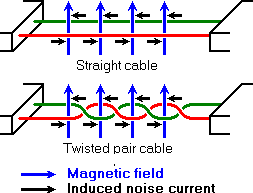
Ref: lammertbies
In RS485 standard, data is transmitted via two wires twisted together also referred to as “Twisted Pair Cable”. The twisted pairs in RS485 give immunity against electrical noise, making RS485 viable in electrically noisy environments.
RS485 at its core with 2 wires allows half-duplex data transmission. This means data can be transmitted in both directions to and fro devices one direction at a time. By adding another 2 wires, making it a 4 wires system, it allows data transmission in both directions to and fro devices at the same time, also known as full-duplex. However, in a full-duplex setup, they are limited to a master and slave communication where slaves cannot communicate with each other.
2 Wire Half Duplex System

Ref: Windmill
TX and RX refer to the transmitted signal and received signal respectively. It is also represented by the orientation of the triangles.
In this setup both the TX and RX share a single pair of wires, therefore it is limited to half-duplex data transmission as the data cannot be transmitted simultaneously to and fro each device.
4 Wire Full Duplex System

Ref: Windmill
Similarly, TX and RX refer to the transmitted signal and received signal respectively. It is also represented by the orientation of the triangles.
Variably, this time both TX and RX have their own 2 wires for data transmission. This means that data can be simultaneously transmitted and received between devices.
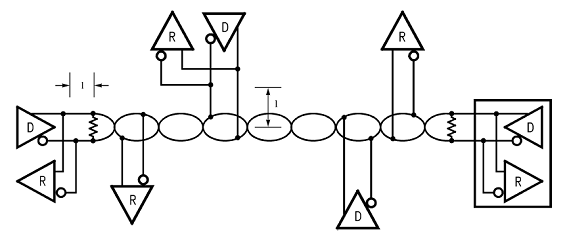
Ref: Robotiq
Devices will be linked together via a bus configuration as shown in the picture above.
Here are the detailed specifications of RS485.
| RS485 | |
| Voltage System | Differential |
| Total Drivers and Receivers on One Line | 32 Drivers, 32 Receivers(One Driver active at a time) |
| Line Configuration | Multidrop |
| Maximum Operational Distance | 1,200M / 3000FT |
| Maximum Data Transmission Rate | 10MBit/s |
| Duplex Mode | Half Duplex or Full Duplex |
| Maximum Driver Output Voltage | -7V to +12V |
| Receiver Input Resistance | 12 kΩ |
| Receiver Input Voltage Range | -7V to +12V |
| Receiver Sensitivity | ±200mV |
Advantages of RS485
RS485 main advantages as compared to other serial communication are tolerance to electrical noise, lengthy cable runs, multiple slaves in one connection, and fast data transmission speed.
RS485 has many advantages over other standards, especially when it comes to applications in noisy industrial environments. The design of RS485 is targeted towards it being tolerant and forgiving to noise and long cable runs with the twisted pair cable arrangement. It allows cable lengths up to 1,200m/4000feet.
Another major advantage is that there can be more than one slave in the connection. Up to 32 slaves can be connected in the system. This is great for Supervisory Control and Data Acquisition (SCADA) systems where there are many devices and it also comes at a very low cost to implement.
Ref: Robotiq
Additionally, data can be transmitted at up to 10MBit/s which is faster than most standards.
These advantages compared to other alternatives made RS485 popular and used in a widespread amount of instances.
RS485 Tools
As mentioned, RS485 is used to link devices instead of other means as it provides significant advantages. However, what if you want to use RS485 in your projects but your device only has USB support? Fret not. There are tools available that can be used to convert your USB ports to RS485.
Seeed Studio RS485 Breakout Board for XIAO and QT Py

- Seamless Compatibility with Seeed Studio XIAO: Designed to work seamlessly with the Seeed Studio XIAO development boards.
- Long-Distance Transmission: Suitable for communication distances of up to 1200 meters (approximately 3973 feet).
- Supports Wide Voltage Input: Compatible with 5V and 12V power supply
- Two Terminal Connection: two 3-pin terminals for both signal wire and power
- Compact Design: The breakout board features a compact form factor (size of 2 XIAO boards), making it suitable for space-conscious projects
SenseCAP S2110 Grove to MODBUS RS485 Converter
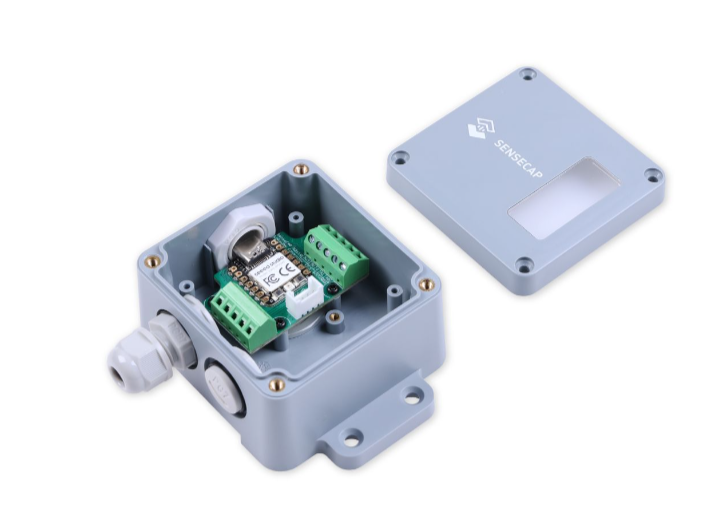
- Easily build MODBUS RS485 industrial-grade sensors: With open-source source code and IP66 enclosure, easily convert over 500+ existing Grove sensors to MODBUS RS485 industrial-grade sensors.
- SenseCAP Data Logger and IoT Platform Compatible: Convert to a SenseCAP LoRaWAN® sensor with SenseCAP Data Logger and take advantage of quick and easy set-up in just 5 minutes with SenseCAP Mate APP.
- Supports Third-party Data Loggers and IoT Platforms: Besides SenseCAP Data Logger, developers could connect to other data loggers that support MODBUS RS485 protocol and third-party IoT platforms.
- Ready-to-deploy Industrial-grade Outdoor Enclosure: IP66 waterproof rate outdoor enclosure with window and waterproof ventilation hole reserved for light and gas sensors, also comes with a customized mounting panel.
USB TO RS232 / RS485 / TTL Industrial Isolated Converter
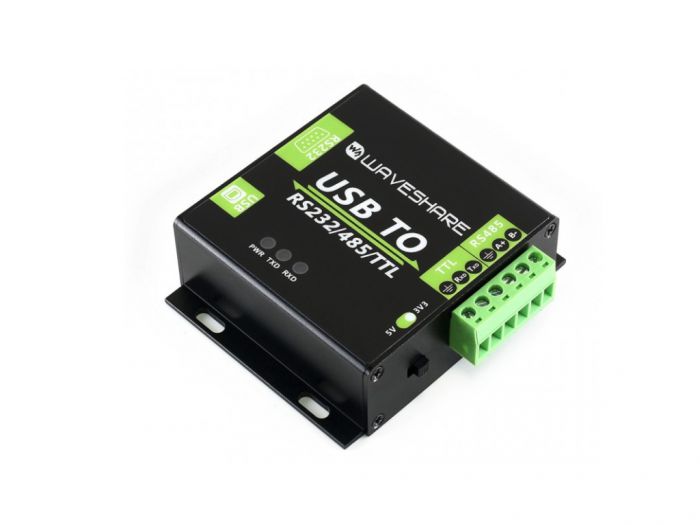
- This converter converts a USB port to not only RS485 but also RS232 and TTL, making it more versatile.
- It also features embedded circuits protection features such as power isolation, ADI magnetical isolation, and TVS diode.
- It is built to last with its aluminium alloy enclosure.
- It is unquestionably an ideal choice for industrial equipment use due to its high speed, reliability, safety and versatility.
Industrial USB to RS485 Converter
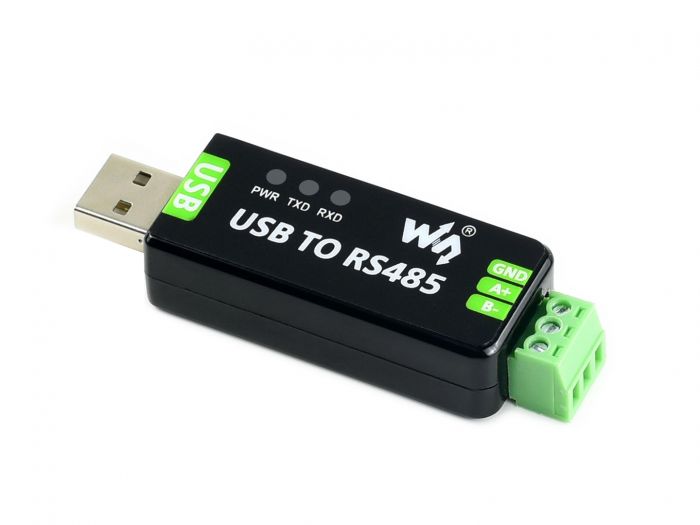
- Clueing in from its name, this is a USB to RS485 converter with industrial-grade features.
- It converts a USB port to use with RS485.
- Best known for the simplicity of usage it provides, it also features embedded circuits protection features such as lightning-proofing, resettable fuse, ESD protection and TVS diode.
- It allows for automatic transceiving, providing convenience.
- It is also an ideal choice for industrial equipment use due to its high speed, reliability and safety.
SenseCAP S2100 LoRaWAN Data Logger, Supports RS485/Analog/GPIO Interfaces, LoRaWAN Converter
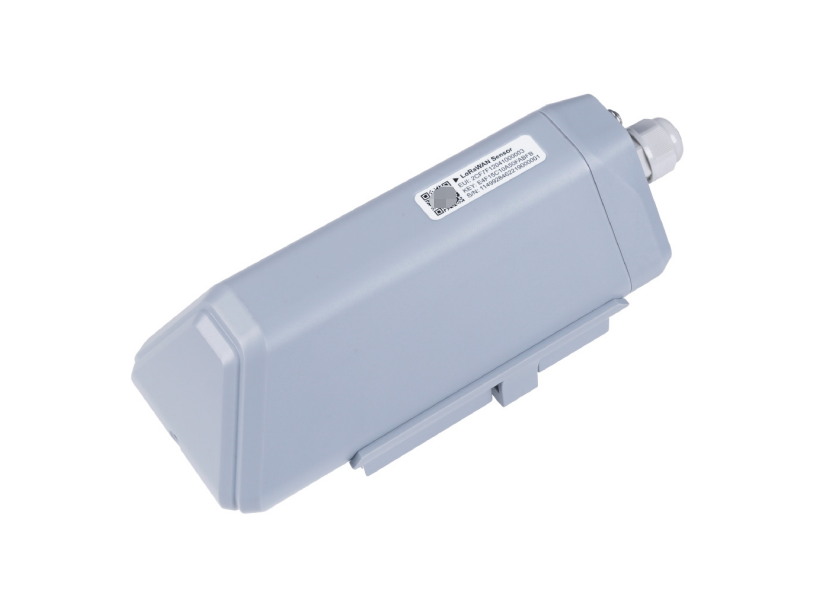
- Strong Compatibility with Sensors: It can support 100+ industrial sensors including various sensor types such as Analog(0~10V/4~20mA), RS485, and GPIO(Pulse).
- LoRaWAN Wireless Transmission: Ultra-low power consumption and ultra-wide-distance transmission range. It has Max.10 year of battery life and can cover a transmission range of 2km in urban scenes and 10km in line-of-sight scenes.
- Industrial Design: -40℃ ~ 85℃ operating temperature and IP66 rating, suitable for indoor, outdoor, and harsh environments such as high UV exposure, heavy rain, dusty conditions, etc.
- Easy to Use: The sensor can be used out-of-box through Bluetooth configuration, and users receive the data on the phone, cloud servers, and different platforms in just a few clicks.
- Powerful APP Support: SenseCAP Mate APP allows you to set the sensor templates and quickly turn the data logger into the sensor you want. Templates can be exported and imported to support various applications.
- Compatible with Worldwide LoRaWAN networks: It can be used with different types of LoRaWAN gateways and is compatible with multiple LoRaWAN Network Servers (Helium, TTN, etc).
SenseCAP S2100 data logger can collect data from multiple sensors and transfer the data through the LoRaWAN network. It is a LoRaWAN converter that converts those sensors that are not LoRa-powered into LoRa-enabled sensors and therefore transfers data through the LoRaWAN protocol. You can easily enjoy the advantages such as low power consumption and long transmission range, without affording the cost of changing the sensors you are using.
It is optimal for outdoor use cases that need reliable data collected over years. With Bluetooth 5.0 for easy configuration and firmware upgrade, It is also compatible with a wide range of frequencies(863MHz ~928MHz), different gateways, and LoRaWAN network servers.
SenseCAP Industrial-grade 4G Data Logger with MODBUS-RTU RS485 protocol
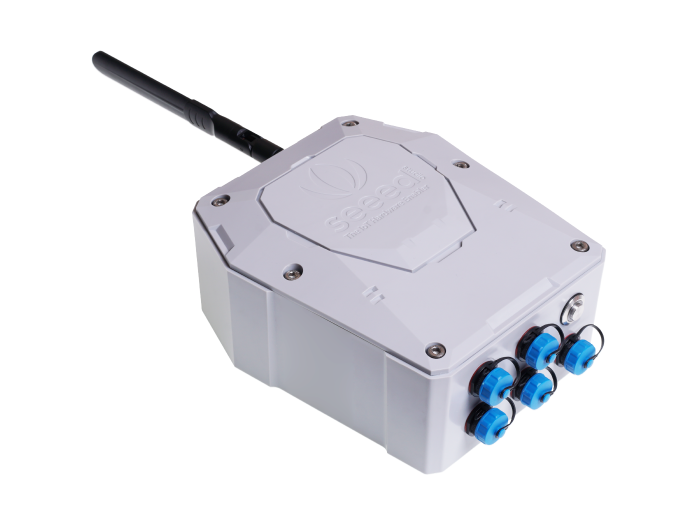
- This is an Industrial-grade 4G Data Logger from the Seeed’s SenseCAP product series.
- It can connect up to 32 RS-485 sensors, designed by industry standards.
- It is IP66 rated, waterproof and dustproof, which makes it ideal for long-term remote environmental monitoring in indoor and outdoor severe environments.
- The data collected can be sent to your server via cellular 2G/3G/4G!
- It comes in two versions, one with DC only, and another with a built-in rechargeable battery.
- This is a complete data logger for your Industrial IoT needs!
SenseCAP is a wireless sensing platform developed specifically for Industrial IoT, with applications in smart agriculture, smart cities, and other environmental sensing scenarios. It is made up of hardware products (sensors, data loggers, and gateways, for example), software services (SenseCAP portal, mobile App, open dashboard), and an API for system and data management. SenseCAP is compatible with a variety of communication protocols, including LoRa, 2G, 4G, NB-IoT, and more. Find out more here!
Industrial IP68 Modbus RS485 1-to-4 Splitter/Hub
The aforementioned SenseCAP Sensor Hub at its stock has only 4 ports to connect RS485 sensors despite it being able to support up to 32 different RS485 sensors.
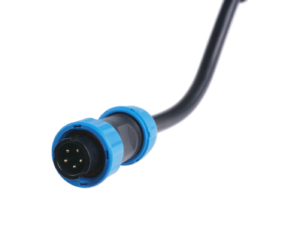
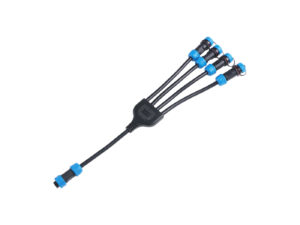
This is where the RS485 1-to-4 Splitter/Hub comes in! Designed to be used with the SenseCAP Sensor Hub, this splitter is able to “split” one MODBUS RS485 port into 4. The RS485 splitter has one male interface that connects to the Sensor Hub and four female interfaces that link to the sensors.
Being a connector that is frequently used outdoors in severe environments, it is designed to be IP68-rated waterproof and dustproof. This means that it is protected from contact with all dust particles, and also high-pressured water jets! It has anti-ultraviolet and anti-rain features as well, making it suitable for long-term outdoor use.
Industrial EC & TDS Sensor B MODBUS-RTU RS485
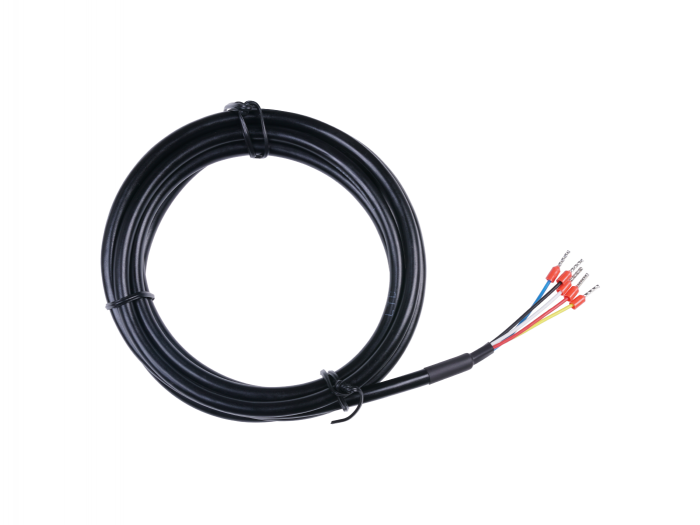
- Here’s an example of a SenseCAP RS485 sensor! This is a sensor that can collect data for Electrical Conductivity (EC) and Total Dissolved Solids (TDS) in Liquids.
- It comes with temperature compensation to compensate for the temperature changes for a more precise reading.
- Designed with industry standards, it comes with a waterproof aviation connector to ensure that your connection will not be affected by the elements.
- It is designed with RS485 built-in to be connected to the above data logger, where the data will wirelessly transmit to the cloud.
- There is a whole plethora of SenseCAP industrial-grade sensors, and this is just one of the many! Find out more here!
Learn more about Seeed’s IIoT

Here at Seeed, we believe that the Internet-of-Things (IoT) will be a new class of digital and physical infrastructures that will allow a more intelligent society. The cornerstone of this complex system is a dependable physical sensing network!
With best-in-class IIoT solutions constructed with premium products and services, Seeed aims to serve smart agriculture, smart weather stations, smart cities, and other environmental-sensing scenarios.
Our range of IIoT products is wide, with different sensors and hubs for different scenarios and requirements. Find out more about our different IIoT product solutions here!
Which one to choose?
Their main difference boils down to one having only support for RS485, while the other one supports RS232 and TTL as well. If you’re very sure that you are only using RS485 then you will not be disappointed with the former. However, if you’re looking to experiment, the latter will provide you with more versatility.
Summary
RS485 is made for serial communication with high speeds, support for long distances, and support for multiple devices (slaves). In a place where you are hindered by the electrically noisy environment, RS485 will be the optimal choice.